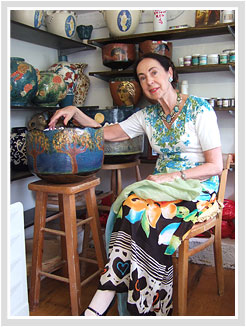About Elżbieta Marylska-Łuszczewska Stanhope
- Your artistic beginnings and inspirations?
- Undoubtedly my parents - both very talented painters who studied painting in Warsaw, Munich and Paris. Painting and art surrounded me from my earliest childhood so I grew up with the unshakeable belief that there is nothing more important in life than ART!
- What are the things that influence you the most?
- Nature first and foremost, changing seasons, colours, light - also music which is a great source of inspiration for me.
- Why ceramics as a medium?
- I love the feel of clay, the contact with this wonderfully tactile medium. Before I took up ceramics I was painting icons - but they restrict the creator because in painting them one has to follow a certain pattern and rules - by comparison ceramics are totally free of any rules, give full rein to the imagination.
- What about Dubrovnik as an artistic inspiration?
- One can only describe my first encounter with Dubrovnik (two years ago) as a "coup de foudre". I arrived at night, dog-tired went to my little seaside hotel, staggered onto the beach the next morning and in the evening went to Dubrovnik town. And there it was - this beauty in white stone, this ancient city which overwhelmed me with its beauty and moved me almost to tears with its bravery in the face of the 1991 aggression. You had told me that when the bombs were falling on Dubrovnik you kept your gallery open - amazed I asked: "But Tea, who would come to the gallery during the bombardment?" "No one" was your answer - but "I was there!" Now, I , as a Pole understood immediately this act of defiance in the face of overwhelming odds - It has reminded me of the splendid but doomed charge of the Polish cavalry against the German tanks in September 1939. The Croatian and the Polish people have a lot in common - we are brave and incurably romantic!
- And Dubrovnik as a place to relax and recuperate?
- Absolute bliss! The crystal-clear waters of the sea with its unique emerald colour, the countless charming restaurants under the sky, the people - everything makes for a wonderful place to relax and be happy!
- Considering the small space of Artur, how do you feel about exhibiting there?
- It is ideal, considering the mind-boggling difficulties of transport - for my exhibition here I have made works much smaller than usual and also the number I am showing is less than usual (in fact about half).
- You speak several languages, you live outside your own country - how much for you does your art transcend places or connect you to particular places?
- I am Polish and Poland is the country I love best, but art knows no boundaries and transcends parochial attachments to one place. An artist is truly a citizen of the world! Because of my husband's work I have been lucky enough to have travelled extensively in Europe, the Middle and Far East. I have seen and was influenced in my work by lots of beautiful sights - I feel I am truly a citizen of the world!
